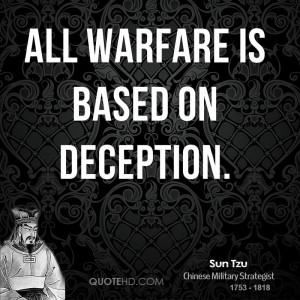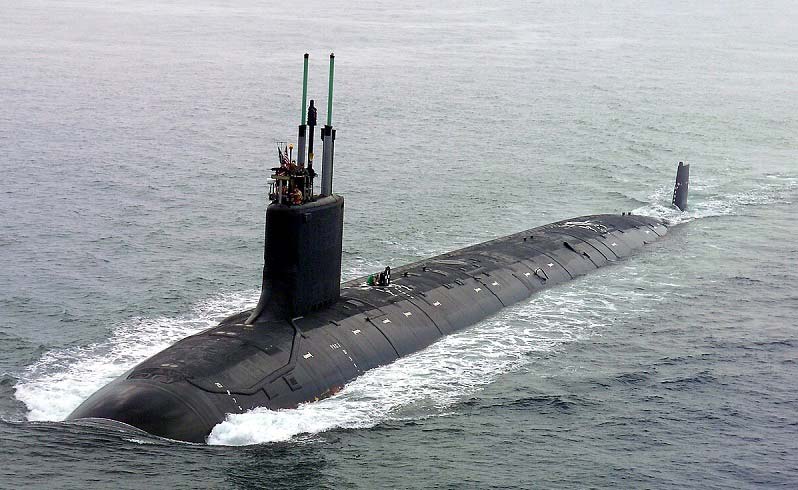
There are many types of deception, including spreading false information, concealing the truth, disguising oneself, conducting demonstrations, and employing feint tactics. In fact, deception tactics in warfare date back to ancient history. The ancient Chinese military classic “The Art of War” particularly emphasizes the importance of deception in military strategy, which is seen as an effective means to defeat powerful enemies with the weak.
What did Sun Tzu say about deception?

In the first chapter of Sun Tzu’s Art of War, LAYING PLANS, Sun Tzu mentioned that “All warfare is based on deception.” In Sun Tzu’s view, war is a process of competing “deceptions” between the two sides. Deception is the core and foundation of all strategies, so Under the general guidance of this sentence, 12 methods of deception are discussed.
Sun Tzun said: “All warfare is based on deception.
Hence, when able to attack, we must seem unable; when using our forces, we must seem inactive; when we are near, we must make the enemy believe we are far away; when far away, we must make him believe we are near.
Hold out baits to entice the enemy. Feign disorder, and crush him. If he is secure at all points, be prepared for him. If he is in superior strength, evade him.If your opponent is of choleric temper, seek to irritate him. Pretend to be weak, that he may grow arrogant. If he is taking his ease, give him no rest.If his forces are united, separate them.
Attack him where he is unprepared, appear where you are not expected.
These military devices, leading to victory, must not be divulged beforehand.”
The goal of the “way of deception” is to maximize our advantages and minimize our opponent’s advantages. Deception involves not only manipulating the opponent’s understanding of his or her capabilities and intentions, but also manipulating the situation to further reduce the opponent’s capabilities.
The art of military warfare is ever-changing and requires the flexible application of various means to confuse and deceive the enemy. It means constantly creating false intelligence, preventing the enemy from understanding our true intentions, thereby disrupting its strategic thinking, military deployment and action pace. In this way, the enemy may be deceived by our actual intentions and become unprepared. The trick to deception is to be ever-changing and unexpected. Ultimately, we have to choose the right moment to attack when the opponent is unprepared. These are key strategies for military strategists to defeat their enemies and should not be easily revealed to others.
According to Sun Tzu, author of “The Art of War” ,deception is also a great way to gain information about your opponent. If they attack you thinking you are weak, you know how aggressive and greedy they are.
The rise of deceptive warfare
In China 2,500 years ago, wars were conducted strictly in accordance with traditional procedures and ritualized methods. First, the two sides determined the date and location of the battle, and then began to make necessary battle preparations. Military legitimacy relies on following established military protocols. In this case, if you go to the battlefield without forming a formation, it cannot be considered a real battle. Even if victory is achieved, it can only be called “defeating such-and-such an army”.
Sun Tzu’s Twelve Ways of Deception may not have been widely accepted at first in a traditional, ritualized context. People at the time tended to revere scriptural precepts as a source of moral guidance, so the use of deception in warfare was considered immoral.
However, as time went by, people began to realize that the essence of war was competition and survival, not just compliance with rituals and rules. Commentators on Sun Tzu’s Art of War began to emphasize the importance of actually achieving victory, and deception became an effective tactic. This gradually changed the way people viewed deception in warfare, viewing it as a strategic tool rather than a moral issue.
Thus we can see that Sun Tzu’s view of war deception was indeed epoch-making in the Chinese context of the time.
The use of deception

Essentials of Sun Tzu and the Art of War and Submarine Operations, written by the PLA Navy Submarine Academy, for instance, provides four examples of how “warfare is a way of deception” might be applied to submarine operations.
- “Show yourself to deter the enemy”: This principle emphasizes the deterrent power of submarines. The submarine’s powerful attack capabilities can be used to intimidate potential enemies into taking action at a specific time or place.
- “Display falsehoods to confuse the enemy”: Deploying a small number of submarines to non-main theaters while deploying more submarines in main theaters can confuse the enemy’s judgment.
- “Creating momentum and harassing the enemy”: When submarines are operating remotely in vast oceans, they can create the illusion that the submarines are there anytime and anywhere, causing the enemy to be fortified everywhere but unable to defend everywhere, thus distracting the enemy’s forces.
- “Deceive the enemy by deception.” If the submarine cannot actually reach the combat area due to its slow speed, deception can be used. Deliberately leaking incorrect information to the public could lead an adversary to believe that submarines are operating in critical waters. This can deter adversary warships, especially those with poor anti-submarine capabilities.
Historical example: All wars are based on deception
Here are two of the most elaborate hoaxes from World War II:
Ghost Army

In the European battlefield of World War II, the 23rd Special Forces Group of the United States, nicknamed the “Ghost Army“, was a special force whose mission was to impersonate other U.S. Army units. This team consists of 82 officers and 1,023 soldiers. They are equipped with no real weapons, but they have fought many “tough battles” by creating realistic illusions. Their equipment includes inflatable rubber tanks, cannons, cars, flash bombs, audio equipment, camouflage nets, etc. Each member also wears the epaulettes of different units. From the second half of 1944 to the first half of 1945, this unit continuously “played” the roles of the U.S. 5th Armored Division, 4th Infantry Division, 6th Armored Division, 90th Infantry Division and other units, performing scenes of realistic dramas.
In one mission, they disguised themselves as a tank battalion and a field artillery battalion in Brest, France, creating realistic battlefield sounds and deceiving the Germans. On another occasion, they camouflaged themselves as armored divisions in southern Luxembourg, frightening German infantry divisions. On another occasion, they pretended to be resting American troops, provided cover for the real troops, and then suddenly attacked the German troops. Their most exciting performance occurred in March 1945, when they created a realistic illusion for the US military’s river crossing operation and successfully broke through the Rhine River defense line. This ghost army played a key role in achieving important Allied victories by creating realistic illusions and deception.
Operation Fortitude
Operation Fortitude was a preparatory activity for the Allied forces before the Normandy landings in World War II. This military deception was intended to prevent the Germans from deploying large numbers of troops in Normandy by trying to convince the Germans that the Allies would attack outside the Normandy area. In addition, preventing the German army from organizing soldiers to counterattack in the Normandy area is also an important part of this operation. The operation was so successful that the Germans even considered the Normandy landings to be a feint.
Extended reading
Meaning of Sun Tzu’s quote Know the enemy and know yourself
Meaning of Sun Tzu win without fighting
Meaning of Appear Weak when you are Strong